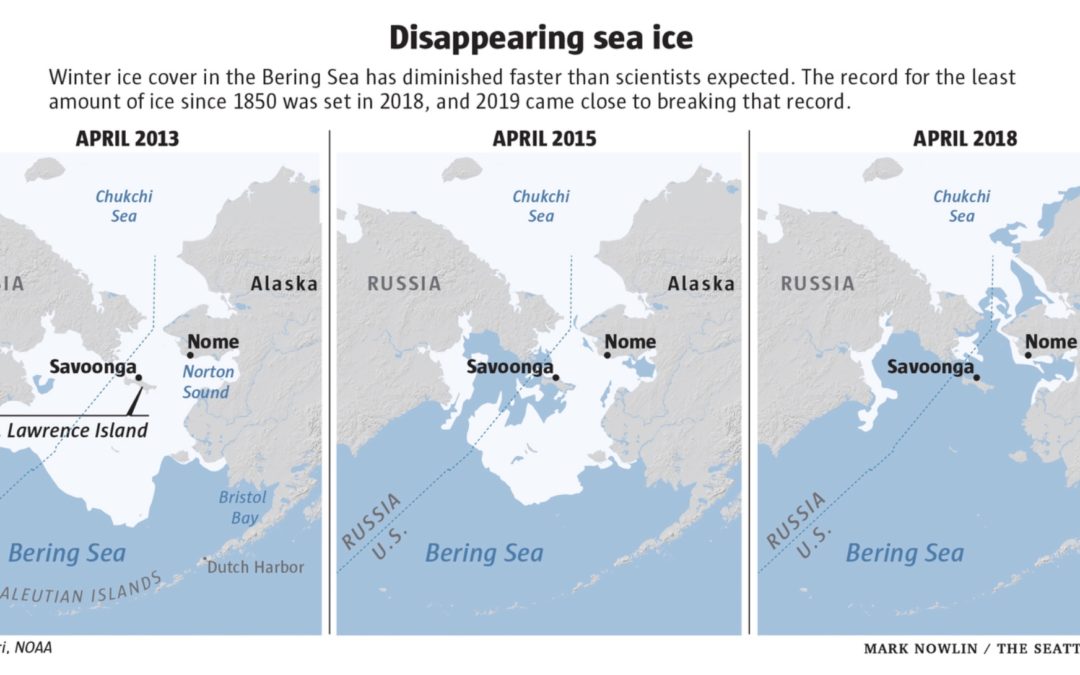SOURCE: Seattle Times
DATE: September 15, 2019
SNIP: For two years, the Bering Sea has been largely without winter ice, a development scientists modeling the warming impacts of greenhouse-gas pollution from fossil fuels once forecast would not occur until 2050.
This ice provided a giant platform for growing algae at the base of the food chain, and has been a significant contributor to the remarkable productivity of a body of water, stretching from Alaska to northeast Russia, that sustains some of the biggest fisheries on the planet.
Much of U.S. seafood – ranging from fish sticks to king crab legs – comes from the Bering Sea, which generates income for an arc of communities that reaches from Savoonga to Seattle, where many of the boats that catch and process this bounty are home-ported.
For Native people such as Akeya, who is Yup’ik, the ice also has shaped their culture, helping them to hunt the walruses, whales, seals and other marine life that have long formed a crucial part of their diet.
Researchers now are uncertain when and to what extent the ice may return, and have scrambled to better understand the consequences of back-to-back years of its loss.
This summer, the pace of change also quickened on shore as a record-shattering heat wave contributed to the deaths of salmon before they could spawn, to wildfires that shrouded the city of Anchorage in smoke, and to the further melting of permafrost, which causes ground to shift and can create problems for buildings and roads.
Offshore, temperatures in some spots at the bottom of the northern Bering Sea this summer measured more than 12 degrees Fahrenheit higher than nine years earlier.
The warming supports the spread of toxic algae blooms, which have been found not only in the northern Bering Sea but in Arctic waters. Scientists aboard the U.S. Coast Guard Cutter Healy in August detected the toxins at surprisingly high levels in two spots in the Beaufort and Chukchi seas, raising concerns about the impacts on marine life.
The Bering Sea changes brought about by the lack of winter ice represent “the ecosystem of the future,” said Phyllis Stabeno, a Seattle-based oceanographer with the Pacific Marine Environmental Laboratory who has studied this body of water for 30 years. “As a scientist, I’m fascinated by it. But as a human being, I’m depressed.”
In harsh winters – full of winds from the north – the ice used to extend south from the Bering Strait almost to the Alaska Peninsula. Even in milder years, it typically stretched for hundreds of miles.
The ice froze through the fall and winter, shedding very cold, very briny seawater that – due to its density – would sink and eventually form a frigid layer down deep. Pollock, cod and many other species avoided the cold pool, and it often kept them from swimming north.
As the ice melted in the spring, it gave marine life a big boost.
Blooms of the ice algae — known as phytoplankton — spread through a less-salty band of water close to the surface, which also was rich in other forms of algae. All of this was a buffet for zooplankton, tiny creatures such as copepods and krill that are rich in fats and are key food sources for young fish, birds and some marine mammals.
When there’s no ice, there are still later blooms of phytoplankton. But they support less-fatty zooplankton.
The consequences for fish appear serious.

